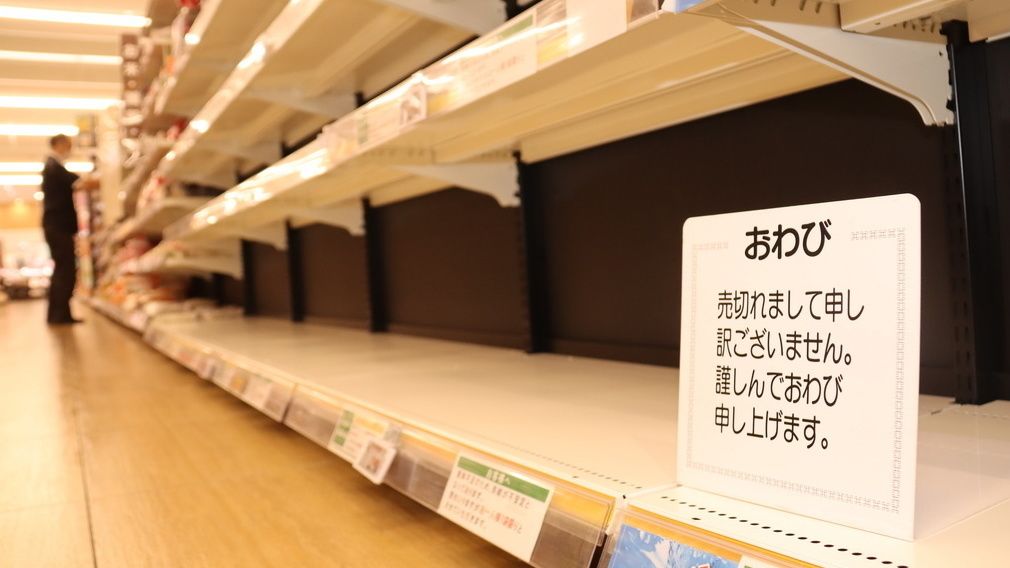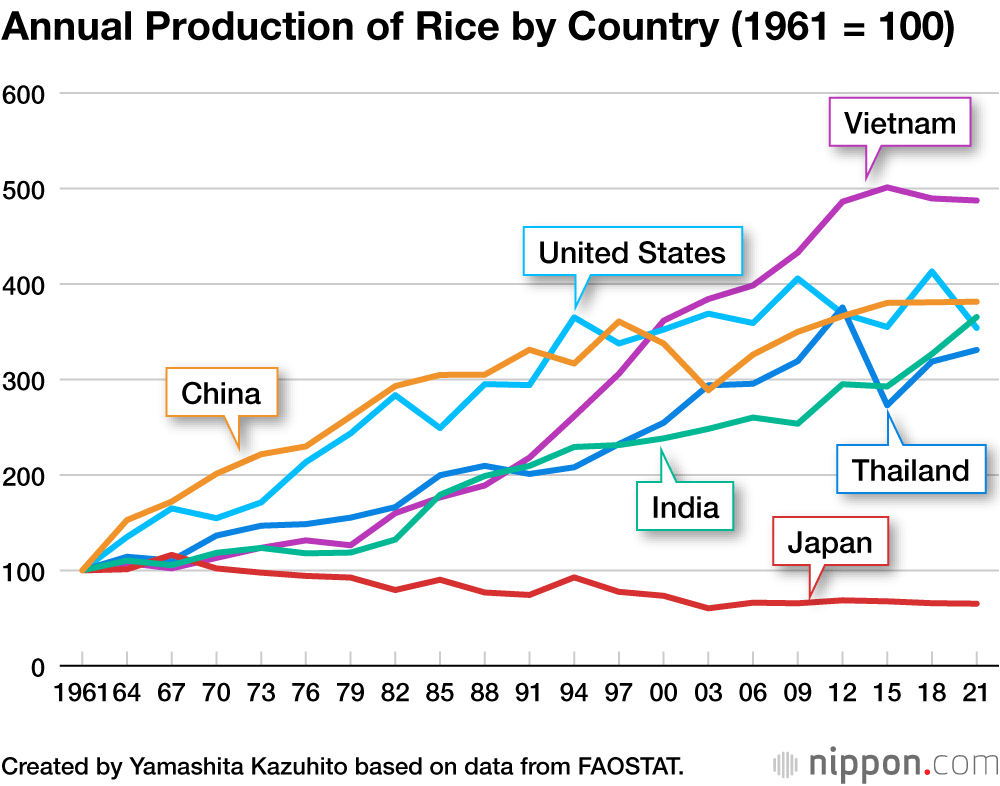Tags
Rice Shortages in Japan: Ongoing Cuts to Production at Fault

Yamashita Kazuhito
Agriculture expert Yamashita Kazuhito argues that the summer 2024 rice shortages in Japan were the result of government efforts to keep rice prices high by reducing the acreage of crops cultivated.
Empty Shelves
In August 2024, rice disappeared from Japanese supermarket shelves, and prices rose, but the Ministry of Agriculture, Forestry, and Fisheries would not admit that there was a shortage.
The searing summer in 2023 had some adverse effect on last year’s rice harvest. Continued high temperatures when rice ears emerge can lead to internal cracking or chalky grains with poor starch formation. This rice is removed at the distribution stage, resulting in a lower supply when it is polished. There were also suggestions that demand rose due to greater consumption by international visitors, the relatively low price of rice compared to bread, or stockpiling due to fears of a Nankai Trough earthquake.
However, these factors only represent a small proportion of overall rice supply and demand, adding up to less than 5%. The fundamental issue is that even small changes in production and consumption have a great influence on the price of rice, and its supply and demand, due to the specific conditions of the food market.
People’s food consumption is limited by their stomachs, so even if production increases, there is a need to slash prices to sell it all in the market. This is the recognized phenomenon where bumper harvests can lead to lower incomes for farmers. Conversely, poor harvests lead to soaring prices. At the same time, even if demand rises, it is not possible to rapidly increase agricultural production. For example, if demand rises in June, it will take until the following September to lift production to bring it in line. This is why small changes in production and consumption can lead to dramatic price swings.
The Real Reason for Shortages
It is favorable for both the Japan Agricultural Cooperatives (JA) and MAFF if the rice supply drops and prices rise. As they are both wary of a glut leading to lower prices, they try to keep the supply low. This year, a slight increase in demand and decrease in supply induced soaring prices for the grain.
However, one fact has not received attention. Last year’s rice-crop index was 101, which was higher than in an average year (set as 100). However, this index is based on the yield for a fixed area, so if the overall cultivated acreage decreases, even if the index is at 100, the amount of rice produced will be less than the previous year.
In 2018, Prime Minister Abe Shinzō boasted he would abolish the gentan policy of reducing rice cultivation acreage, but this was “fake news.” JA and MAFF have continued to promote acreage reductions, based on the premise that demand for rice is decreasing by 100,000 tons every year. Last year’s total rice production was down 90,000 tons from the previous year’s 6.7 million tons. Before talking about the effects of the hot summer of 2024, we should note that the year also saw this decreased supply due to reduced acreage.
The major rice shortages in 1993 were said to have been caused by low summer temperatures, but reduced acreage was the essential reason then too. There was the potential to produce 14 million tons, but this was reduced to 10 million—and then the poor harvest meant 7.8 million tons were actually produced. However, if Japan could produce 14 million tons and export 4 million tons in a typical year, it could likely have produced and consumed 10 million tons even with a cool summer.
Currently, 40% of paddy fields are not in use, meaning that production is limited to around 6.5 million tons. If Japan stopped this policy of reduced production, and instead exported 4 million tons, it could handle the kind of situation seen this year through a small decrease in the amount exported and no domestic shortages. The European Union has dealt with its excess agricultural production through exports rather than reducing cultivation, so it would never have the kind of problem Japan has had with rice.
Rising Prices
Rice is harvested around September and stored in warehouses, to be sold and consumed until the following year’s harvest. The recent issue of empty market shelves came about because it was shortly before the latest harvest. However, MAFF, which has 1 million tons of stockpiled rice, had a whole year in which it knew about heat damage to the 2023 crop. Why did it not act earlier?
JA and MAFF have instructed farmers to reduce production for a number of years now. The price per 60 kilograms of rice traded between the National Federation of Agricultural Cooperative Associations (Zen-Noh) and wholesalers was ¥12,804 for crops harvested in fiscal 2021, ¥13,844 for the 2022 harvest, and ¥15,306 for the 2023 harvest (rising to ¥16,133 in August 2024). This is a 20% rise over two years, to reach the highest price in a decade. Furthermore, the provisional price for this year’s harvest paid by JA to farmers was up between 20% and 40% on last year. The rise in rice prices is clearly the result of JA and MAFF’s efforts. Any release of stockpiled rice to ease the supply crunch would bring the grain back to stores and bring prices down.
MAFF has said that this year’s new rice will solve shortages. However, this rice is basically meant to be consumed from October this year until September next year. Starting on it early will lead to the same issue next August. As 2024 saw high temperatures in summer again, rice prices are not coming down.
Suggested Solutions
The government bears a significant financial burden in order to provide affordable medical services to citizens. In the area of this staple food, by comparison, reducing the cultivated acreage of rice is an extraordinary policy that means giving out total subsidies of ¥350 billion, at taxpayers’ expense, to farmers in order to reduce supply and raise prices, thereby increasing the burden on consumers. Lifting the price of a staple food like rice is even more regressive than a consumption tax.

Global rice production is 3.5 times higher than it was in 1961, but Japan has reduced its own production by 40%, while at the same time providing subsidies to farmers. Naturally, this means a decrease in food self-sufficiency. In prewar Japan, the Army Ministry blocked a proposal to reduce cultivated acreage by what was then the Ministry of Agriculture and Forestry. It is a policy that runs counter to national security.
If Japan abandoned the acreage reduction program, it could produce 17 million tons of rice each year, with 7 million tons for domestic consumption and 10 million tons for export. This would leave plenty of leeway for handling changes in domestic supply and demand.
There is now almost no difference in price between California rice and Japanese rice. The latter is sometimes cheaper. Stopping the acreage reduction policy would bring prices down further and boost exports. Producing more than is consumed domestically would mean a self-sufficiency ratio of more than 100% for this crop. With 17 million tons, rice self-sufficiency would actually reach 243%, and overall food self-sufficiency would rise above 60%. Thus, the most effective food security policy would be to increase production and exports of rice, as this would mean there would be plenty available in an emergency. Japan currently spends ¥50 billion each year on stockpiling rice. Producing excess rice for export during ordinary, peaceful times would perform the same function with no financial outlay.
It is impossible to abandon the acreage reduction policy, however, as it is the basis for JA’s prosperity. The high price of rice has sustained small-scale farmers with dual incomes. They deposit earnings from their main jobs, amounting to more than four times as much as their farming income, in the JA Bank. After losing interest in farming, they also deposit huge sums accrued from the sale of farmland for the sake of its conversion for residential or other nonagricultural usage. This has helped JA to grow into a megabank with over ¥100 trillion in deposits. JA’s maintenance of high rice prices to support dual-income farmers, and the fact it is Japan’s only body that can engage in both banking and other businesses, have combined perfectly to spur its prosperity.
Among the victims of the policy are taxpayers who bear the burden of financing subsidies, consumers who pay high prices for their food, smaller rice wholesalers who go out of business due to the reduced amount of rice handled, full-time farmers who cannot expand their farm size while small-scale part-timers are maintained by the high price of rice, and citizens who would have no food supply if imports were cut off. And notably, there are the rice dealers with no political power, many of whom—unable to object to agricultural policy—have had to shut down their businesses. MAFF is acting in violation of the second section of Article 15 of the Constitution: “All public officials are servants of the whole community and not of any group thereof.”
Some suggest that it would not be possible to maintain rice production if prices fall. However, it is contradictory to reduce production in order to maintain production. The United States and the EU switched a long time ago to protecting farmers’ incomes through direct payments from the government rather than price support. Even if the price of rice drops, payments to full-time farmers would help both them and small-scale dual-income farmers who receive income by leasing farmland to them. This would only cost around ¥150 billion annually.
Farmers used to plant rice in June, after the wheat and barley harvests. With the increase in part-time farmers, planting was pushed earlier, to the Golden Week holiday from the end of April through the first week of May, and the practice of double cropping faded out. Returning planting to June, and harvesting in October, would avoid heat damage to crops, and increased wheat production would also boost food self-sufficiency.
For the benefit of Japan’s citizens, the government should abandon the acreage reduction program of rice, make direct payments to farmers, and revive double cropping.
(Originally published in Japanese on September 27, 2024. Banner photo: A supermarket with empty rice shelves in Okayama, Okayama Prefecture. © Okayama Shimbun/Kyōdō.)
https://www.nippon.com/en/in-depth/d01044/Published Date: November 11, 2024






